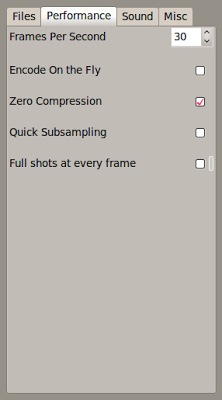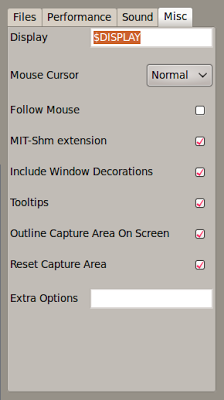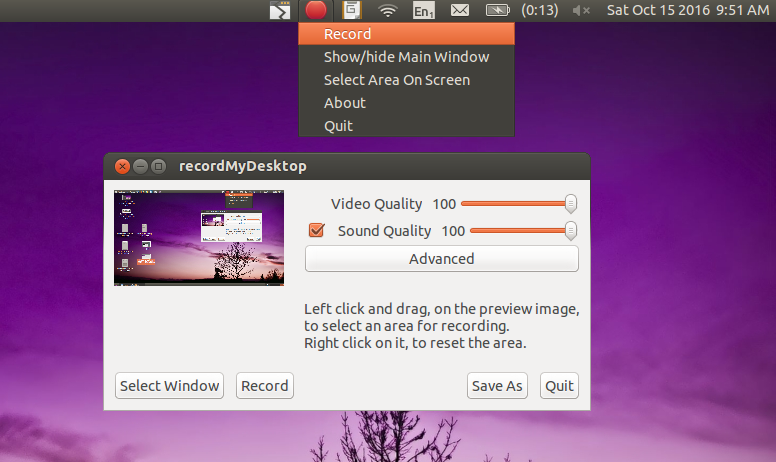Difference between revisions of "Learn Record My Desktop"
| Line 1: | Line 1: | ||
| − | + | {{Template:Book-sidebar}} | |
=Introduction= | =Introduction= | ||
RecordMyDesktop is a desktop session recorder, for GNU / linux that attemps to be easy to use, yet also effective at it's primary task. As such, the program is separated in two parts; a simple command line tool that performs the basic tasks of capturing and encoding and an interface that exposes the program functionality in a usable way. The commandline tool (which essentially is recordMyDesktop), is written in C, while there are two frontends, written in python with pyGtk (gtk recordMyDesktop) and pyQt4 (qt-recordMyDesktop). recordMyDesktop offers also the ability to record audio through ALSA, OSS or the JACK audio server | RecordMyDesktop is a desktop session recorder, for GNU / linux that attemps to be easy to use, yet also effective at it's primary task. As such, the program is separated in two parts; a simple command line tool that performs the basic tasks of capturing and encoding and an interface that exposes the program functionality in a usable way. The commandline tool (which essentially is recordMyDesktop), is written in C, while there are two frontends, written in python with pyGtk (gtk recordMyDesktop) and pyQt4 (qt-recordMyDesktop). recordMyDesktop offers also the ability to record audio through ALSA, OSS or the JACK audio server | ||
Revision as of 12:21, 15 October 2016
Introduction
RecordMyDesktop is a desktop session recorder, for GNU / linux that attemps to be easy to use, yet also effective at it's primary task. As such, the program is separated in two parts; a simple command line tool that performs the basic tasks of capturing and encoding and an interface that exposes the program functionality in a usable way. The commandline tool (which essentially is recordMyDesktop), is written in C, while there are two frontends, written in python with pyGtk (gtk recordMyDesktop) and pyQt4 (qt-recordMyDesktop). recordMyDesktop offers also the ability to record audio through ALSA, OSS or the JACK audio server
ICT Competency
Record my desktop is a tool for Generic Resource Creation
Educational application and relevance
RecordMyDesktop is a program that captures audio-video data of a linux desktop session, producing an ogg-encapsulated theora-vorbis file. recordMyDesktop tries to be as unobstrusive as possible by proccessing only regions of the screen that have changed
Version
The current version is: recordMyDesktosp : 0.3.8.1 gtk-recordMyDesktop: 0.3.8 qt-recordMyDesktop: 0.3.8
Configuration
Need goog input and output sound device
Overview of Features
SimpleScreenRecorder SimpleScreenRecorder is a Linux screen recorder that supports X11 and OpenGL. It is easy to use, feature-rich, and has a Qt-based graphical user interface. It can record the entire screen or part of it, or record OpenGL applications directly. The recording can be paused and resumed at any time. Many different file formats and codecs are supported, and easy to add more. Created 2012-13 and currently maintained code: https://github.com/MaartenBaert/ssr -- but also prepackaged for most popular linux distros. Kazam Kazam is a simple screen recording program that will capture the content of your screen and record a video file that can be played by any video player that supports VP8/WebM video format. Optionally you can record sound from any sound input device that is supported and visible by PulseAudio. VokoScreen A small program to create screen videos including sound recording. Although this program is really small and inconspicious, it includes exceeding capabilities to generate training videos, installation videos, browser and Skype recordings.
Other similar applications
Development and community help
Working with the application
Functionalities

|

|
| Step 1- RecordMyDesktop will appear under Applications > Sounds & Video > Record MyDesktop. Open it and you'll see a window similar to this. You can adjust Video and Sound Quality by adjusting the slider near the top right of this window. If you un-tick the box for Sound Quality, sound will not be recorded (whatever is playing in your speakers). The better the quality of Video and Sound, the bigger will be the size of recorded file. | Step 2-Under the Files Tab, it lists the software's working directory where it will store temporary files. It is set to /tmp by default and I don't think you need to change it. |

|

|
| Step 3- Under the Performance Tab, you can adjust Frame Rate and some other options. Something between 20-30 frames gives reasonable quality. | Step 4-Under the Sound Tab, you can adjust Channels, Frequency of Sound and the Sound Device for recording. You can also use a mic and record your own voice through that. |

|

|
| Step 5-Under the Misc Tab, you can see some other options related to Mouse Cursor, Windows Decorations, Tooltips etc. You don't need to change them. | Step 6-Select window ; select the desktop area which is needed. If not necessary just leave it that option
Record ; If we click record button in the icon bar we identify the red button which is a symbol of record process. If we click on that it will show the command like * Record *Show/hide window *select area on screen * about *Quit save as Quit |

|
Step 7- Once you completed all process to save the file, the loading process will get start as like this image. we need to wait till its get complete. then only we will get output file. if we close before loading completes we not able to see the output file. |
File formats for creation
Not Applicable
Saving the file
Output file will be save on .ogv format
Export and publishing files
Not Applicable
Advanced features
Installation
| Method of installation | Steps |
|---|---|
| From Ubuntu software Centre | Type "Record My Desktop" in search bar and then click Install |
| From Terminal | sudo apt-get install recordmydesktop |
| From the web | http://recordmydesktop.sourceforge.net/downloads.php visit this webpage to download |
| Web based registration | Steps |
The application on mobiles and tablets
In android mobile google play store we have many apps like AZ Screen Recorder ,Screen Recorder etc
